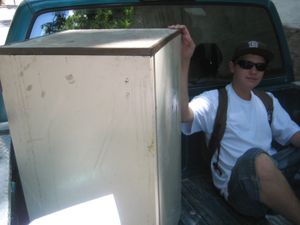(Updated budget table with information that was submitted with the grant.) |
(Changed parts of the introduction.) |
||
| Line 13: | Line 13: | ||
=Objective= | =Objective= | ||
As part of the [[Humboldt State University]] [[:Category:Parras_2008|Parras Summer Program]], | As part of the [[Humboldt State University]] [[:Category:Parras_2008|Parras Summer Program]], we were given the chance to plan and construct an appropriate technology project of our choosing. As the result of a brainstorm in the beginning of the program, we decided that a solar powered refrigeration system would be well suited for the area. The challenge being that it would not utilize electricity as its energy source. | ||
The possibility of hacing a refrigeration system "off-grid" is a huge advantage in Northern Mexico (as well as other parts of the world). There are many circumstances where people do not have access to electricity or gas to power a refrigeration system. For this reason people are not able to store food as they would if they had electricity. Another challenge for all of Mexico's residents is that electricity is relatively expensive. There is the possibility that this project will create a system that is actually more affordable than standard refrigeration. | |||
<!-- <ref>Klein, S. Reindl, D: "[http://www.ashrae.org/content/ASHRAE/ASHRAE/PDF/20058309533_886.pdf Solar Refrigeration]", page S26. ASHRAE Journal. 2005. </ref> --> | |||
=Project Criteria= | =Project Criteria= | ||
Revision as of 04:53, 22 July 2008
Template:Infobox Project Template:TOCnestleft
Objective
As part of the Humboldt State University Parras Summer Program, we were given the chance to plan and construct an appropriate technology project of our choosing. As the result of a brainstorm in the beginning of the program, we decided that a solar powered refrigeration system would be well suited for the area. The challenge being that it would not utilize electricity as its energy source. The possibility of hacing a refrigeration system "off-grid" is a huge advantage in Northern Mexico (as well as other parts of the world). There are many circumstances where people do not have access to electricity or gas to power a refrigeration system. For this reason people are not able to store food as they would if they had electricity. Another challenge for all of Mexico's residents is that electricity is relatively expensive. There is the possibility that this project will create a system that is actually more affordable than standard refrigeration.
Project Criteria
Here is a table of criteria that in our minds define an appropriate technology for the construction of the refrigerator. Competing solutions can be rated on how well they meet each of the following criteria. Then those rating can be multiplied by the criterion weights. The solution with the highest score is accepted to be the most appropriate.
| Criteria | Weight (0-10 highest) |
|---|---|
| Buy back time (economically viable) | 9 |
| Environmental Impact | 9 |
| Safety(for the consumer) | 8 |
| Cost(of construction and of final product) | 7 |
| Efficiency | 7 |
| Simplicity of use | 7 |
| Functionality | 6 |
| Utilizes local materials | 5 |
Planning
Grant Writing
We submitted a grant request to The International Journal for Service Learning in Engineering (IJSLE) for the sum of $1000 USD. The grant discussed the learning possibilities of this project as well as the impact it would have on the community. The grant was submitted on July 4th, 2008. Here is a link to our project outline via ServiceBook: http://www.servicebook.org/content/view/287/112?project_id=143
Collection of Materials

- Broken Refrigerator
The refrigerator was the first part of the refrigerator that we sought out. We obtained it from Gerardo Delgado Ayala at his small, home run refrigerator repair shop at Calle Guerrero #13. The refrigerator had the compressor and other electronics removed. We hope to make use of it for the housing for our project.
- Welding Equipment
Antonio Pachicano 42-2-07-82
Jaime Pachicano 42-2-01-46
Budget
Projected Budget
| Part | Quanity | Estimated Cost (Dollar) | Estimated Total Cost (Dollar) |
|---|---|---|---|
| Refrigerant (Ammonia) | 5 Lbs | $16 | $80 |
| Hydrogen Pressurization | 1 | $16 | 16 |
| Tubing (Steel) | 50 Feet | $3 | $150 |
| Reflector Material | 20 Square Feet | $7 | $140 |
| Reflector Housing | 1 | $60 | $60 |
| Used Refrigerator Housing | 1 | $60 | $60 |
| Welding and Soldering work | 1 | $200 | $200 |
| Stop Valves | 4 | $6 | $24 |
| High Pressure Gauges | 4 | $20 | $80 |
| 1" Discharge Pipe | 2 | $5 | $10 |
| Pipe Mounts | 50 | $.50 | $25 |
| Housing | 1 | $60 | $60 |
| Interpretive Materials | 12 | $2 | $24 |
| Steel Wool | 4 | $5 | $20 |
| Community Demo Signage | 1 | $35 | $35 |
| Community Demo Food | 1 | $120 | $120 |
| Total | $1119 |
Actual Budget
| Part | Date Purchased | Cost (Peso) |
|---|---|---|
| Broken Refrigerator | July 13, 2008 | $100 |
| Bamboo | July 21, 2008 | Free |
| Cord | July 21, 2008 | $18 |
Construction
Testing
Problems
Problem X
Solutions
Solution X
Implementation
See Also
References
- ↑ Klein, S. Reindl, D: "Solar Refrigeration", page S29. ASHRAE Journal. 2005.